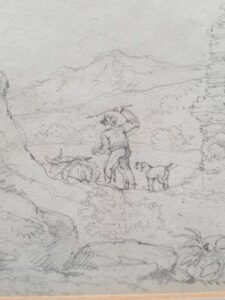






ST1185 WILLIAM ALFRED DELAMOTTE (1775-1863)
A FIGURE PASSING WENLOCK ABBEY, SHROPSHIRE
Pencil drawing
17cm x 23cm, 6 ¾ ins x 9 ins
Indistinct signature lower right.
Reverse inscribed: ‘Wenlock Abbey, Shropshire, WD’
Provenance: Private collection, north Yorkshire, UK
HISTORY OF WENLOCK PRIORY [From the English Heritage website]
Wenlock was the site of a monastery for almost 900 years. An abbey for both monks and nuns was founded here at the end of the 7th century and was the home of St Milburga, an Anglo-Saxon princess. It was refounded at the end of the 11th century as one of the first Cluniac monasteries in England.
After monastic life ended at Wenlock in 1540 during Henry VIII’s Dissolution of the Monasteries, the church and other buildings were rapidly reduced to ruins.
William Alfred Delamotte (Weymouth 1775 – 1863 Oxford), was an English painter and printmaker.
Delamotte was the son of a French refugee. His remarkable drawing skills were apparent from an early age, so that he enjoyed the royal patronage of King George III. After having exhibited at the Royal Academy in 1793, he enrolled at the Royal Academy Schools the following year, becoming a student of Benjamin West, another of the King’s protégés and President of the Royal Academy. Even during these years of study, Delamotte chose to turn his attention to architectural and landscape work.
From the Academy he moved to Oxford, depicting its buildings in numerous sketches. Many of his drawings were made into woodcuts by Orlando Jewitt of Headington.
In 1803 he accepted the post of drawing-master at the newly established Royal Military College, Sandhurst, a position he held for forty years.
Besides producing watercolours and a few oils, he turned to printmaking by way of etching, lithography and soft-ground etching.
[Source: Wikipedia]
 Go back to Works of art
Go back to Works of art








